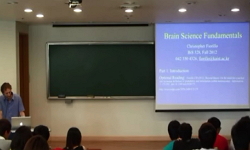






| 1. |  |
Introduction | 1. Introduction of this course 2. Overview of mechanics |
 |
 |
Introduction | 1. Introduction of this course 2. Overview of mechanics |
  |
|
| 2. |  |
The Goal of the Brain | 1. Function of Brain 2. Information, probability and prediction |
 |
 |
The Goal of the Brain | 1. Function of Brain 2. Information, probability and prediction |
  |
|
| 3. |  |
Overview of Function | 1. Information flows through molecular sensors 2. Information transformation in sensory-motor pathway |
 |
 |
Overview of Function | 1. Information flows through molecular sensors 2. Information transformation in sensory-motor pathway |
  |
|
| 4. |  |
Overview of Structure | 1.Structure of neurons 2. Classifying neurons |
 |
 |
Overview of Structure | 1. Structure of neurons 2. Classifying neurons |
  |
|
| 5. |  |
Membrane voltage : passive properties(1) | 1. properties of water, ion, and neuronal membrane 2. ion channels, equilibrium potential and resting potential |
 |
 |
Membrane voltage : passive properties(1) | 1. properties of water, ion, and neuronal membrane 2. ion channels, equilibrium potential and resting potential |
  |
|
 |
Membrane voltage : passive properties(2) | 1. an equivalent circuit of neuronal membrane 2. common features of ion channels 3. function of action potential |
 |
|
| 6. |  |
Membrane voltage : active properties(1) | 1. patch clamp recording 2. action potential and voltage gated ion channel |
 |
 |
Membrane voltage : active properties(1) | 1. patch clamp recording 2. action potential and voltage gated ion channel |
  |
|
 |
Membrane voltage : active properties(2) | 1. Hodgkin-Huxley model and action potential conduction 2. Ion channel diversity |
 |
|
 |
Membrane voltage : active properties(3) | 1. Three Key Properties of Voltagegated Ion Channels 2. Conduction velocity |  |
|
| 7. |  |
Voltage-Regulated Channels | 1. Functional Classification of Ion Channels 2. Maintaining Homeostasis |
 |
 |
Voltage-Regulated Channels | 1. Functional Classification of Ion Channels 2. Maintaining Homeostasis |
  |
|
| 8. |  |
Synapse (1) | 1. synaptic transmission and release probability 2. paired pulse depression and facilitation |
 |
 |
Synapse (2) | 1. synaptic transmission and release probability 2. paired pulse depression and facilitation |
 |
|
 |
Synapse | 1. synaptic transmission and release probability 2. paired pulse depression and facilitation |
  |
|
| 9. |  |
Neurotansmitters, Receptors, and Signal Transduction (1) | 1. Dale s principle 2. Types of neurotransmitter |
 |
 |
Neurotansmitters, Receptors, and Signal Transduction (2) | 1. Receptors : ionotropic receptor, metabotropic receptor 2. G protein and second messenger |
 |
|
 |
Neurotansmitters, Receptors, and Signal Transduction |   |
||
| 10. |  |
Gross Anatomy of the Brain (1) | 1. Anatomical terms |  |
 |
Gross Anatomy of the Brain (2) | 2. major division of CNS and cortex, and brodmann map |  |
|
 |
Gross Anatomy of the Brain | 1. Anatomical terms 2. major division of CNS and cortex, and brodmann map |
  |
|
| 11. |  |
Theory of learning (1) | 1. input and output of a neuron |  |
 |
Theory of learning (2) | 2. Hebbian and anti-hebbian plasticity |  |
|
 |
Theory of learning | 1. input and output of a neuron 2. Hebbian and anti-hebbian plasticity |
  |
|
| 12. |  |
Development of Connectivity (1) | 1. Development of neuronal structure |  |
| Development of Connectivity (2) | 2. Synaptic rearrangement in LGN and visual cortex | |||
 |
Development of Connectivity | 1. Development of neuronal structure 2. Synaptic rearrangement in LGN and visual cortex |
  |
|
| 13. | Mechanisms of Learning (1) | 1. Model for the study of associative plasticity : hippocampus 2. Glutamate receptors 3. Long term potentiation and depression(LTP, LTD) |
||
| Mechanisms of Learning (2) | 1. Habituation and Sensitization of Gill-Withdrawal Reflex 2. Classical conditioning in Aplysia 3. Synaptic timing dependent plasticity(STDP) |
|||
 |
Mechanisms of Learning | Mechanisms of learning and plasticity in neurons |   |
